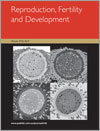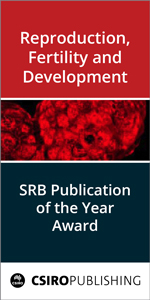Reproduction, Fertility and Development
Volume 27
Number 3 2015
Over the last decade in vitro manipulation techniques of pig embryos have been used increasingly, but the overall tendencies and main problems are not well known. In this first systematic review we show that using more in vitro manipulations of porcine embryos decreases the overall production of piglets, and that nuclear transfer has developed markedly and now gives more stable results. This new knowledge illustrates the present status of in vitro techniques, and it will also be useful in the continuing attempts to identify problems and find solutions for nuclear transfer.
Effective methods for tissue cryopreservation should protect cell viability and genome integrity. This study used the TUNEL assay and detection of γH2AX foci to investigate DNA damage in goat ovarian tissues cryopreserved with a new vitrification method (the Ovarian Tissue Cryosystem). This vitrification method preserved both morphology and DNA integrity of goat preantral follicles and therefore represents a potential alternative for ovarian tissue preservation in other species.
Induced sex manipulation in fish is connected with better aquaculture production and sex control. Masculinisation in sexually undifferentiated common carp was attempted using non-steroidal tamoxifen and letrozole, which resulted in highly significant changes, particularly for letrozole, which produced almost all male C. capio. These findings open a new avenue for the application of commercial letrozole in monosex fish production.
Adiponectin isoforms mediate different aspects of the pleiotropic function of the protein, including the reproductive process. We demonstrated that lower abundance of circulating adiponectin isoforms and altered ovarian adiponectin system expression are related to lower porcine fertility. These data present new elements contributing to a better understanding of the role of adiponectin in the reproduction and extends previous observations that reduced circulating adiponectin is associated with reproductive disorders, including PCOS. These findings open a new avenue for the application of commercial letrozole in monosex fish production.
The Nsun7 gene with location 4p14, encodes putative methyltransferase Nsun7, has a role in sperm motility. Analysis of the direct sequencing of PCR products of exon7 showed a T26248G-transversion mutation with protein folding and function exchange in asthenospermic men, which may lead to reduced sperm motility and infertility. Based on, it can be helpful as an infertility marker for males with a history of subfertility or idiopathic infertility in fertility assessment.
Researchers have paid much attention to gamma-tocotrienol (GTT) due to its strong anti-oxidant properties. Therefore, the effects of GTT on blastocyst development, expression levels of reactive oxygen species and apoptotic index were investigated in preimplantation porcine embryos. We revealed that GTT improves the developmental competence and quality of porcine embryos by preventing oxidative stress.
To cope with varying ecological costs some species delay their first breeding, but delaying the first reproduction generally involves reproductive costs. We show here in a wild-type rodent (Mus spicilegus) that the delayed reproducers reproduce as well and more quickly than younger first-time breeders. The hypothesis of a lower reproductive potential in these relatively aged individuals seems to be contradicted.
As experienced by many couples that undergo assisted reproduction, the oocyte quality is crucial for correct development. This study shows that Fsh and Lh receptors on the cumulus cells that surround the mouse oocyte are differentially expressed in developmentally competent or incompetent gametes. The method presented is a potential non-invasive procedure to discriminate between oocytes of good or bad quality.
Studies on the protein components of ovarian fluid (OF) may contribute to a better understanding of the mechanisms underlying oocyte development and quality. A shotgun proteomic approach was used to identify 54 proteins of in the OF of rainbow trout; most of the proteins are described for the first time in fish OF. The results of this study could help in the decoding of the biological function of these proteins and in the discovery of potential biomarkers of oocyte quality.
By identifying differences between good and poor quality oocytes (i.e. eggs), methods for improving oocyte quality may be ascertained. This research discovered differences in the distribution, number and structure of mitochondria and the volume of storage vesicles, between adult (good quality) and juvenile (poor quality) sheep oocytes. Treatments that can alter these cell organelles in the oocytes, either in the laboratory or the animal, may now be identified to improve oocyte quality.
The detection of causal mutation in genes improves genetic evaluation of animals. The aim of the present study was to search for causal mutations in the TOX and NCOA2 genes and relate them to reproductive traits in beef cattle. Two single nucleotide polymorphisms in the NCOA2 gene were associated (P < 0.05) with early pregnancy probability, age at first calving and days to first calving.
Eel culture requires closing of the life cycle in captivity. We have characterised sperm subpopulations in eel sperm by cluster analysis of CASA data. Keeping male eels at 20°C and using recombinant human chorionic gonadotropin (hCGrec) resulted in early and stable spermiation, with a higher proportion of a high quality subpopulation.
Oocytes from sexually immature pigs are used for in vitro production techniques studying, for example, human diseases. The objective of the present study was met by developing a method for the selection of prepubertal oocytes with high developmental competence by measuring the oocyte’s diameter in combination with morphological evaluation. The study is important for understanding oocyte growth and development and for increasing the efficiency of in vitro work.
The mammalian epididymis is responsible for sperm maturation and is critically regulated by testicular factors. Comparative proteomics was used to discover key testis-dependent proteins in epididymides from castrated mice. The results showed that the differentially expressed proteins participated primarily in energy metabolism and the antigen processing and presentation pathway. Our findings may provide potential new candidates for further studies into epididymal function and male aging.
We hypothesised that Rgs2 may play a role in early embryo development. Therefore, we investigated the localisation of Rgs2 in mouse ovarian tissues and early embryos, and determined the effect of downregulating Rgs2 on the development of early embryos. Rgs2 was abundant in mouse early embryos, and the results of Rgs2 knockdown indicate that Rgs2 plays a critical role in early embryo development.




